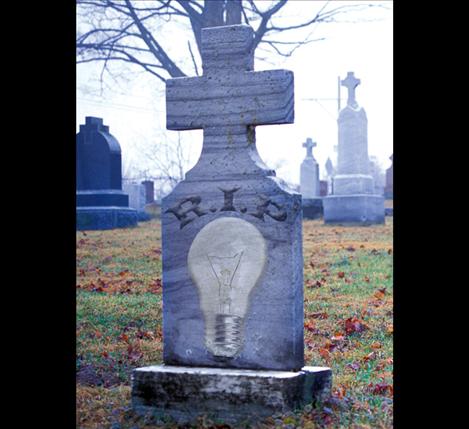Last incandescent light bulbs being phased out
Hey savvy news reader! Thanks for choosing local.
You are now reading
1 of 3 free articles.
After a 212-year lifespan of illuminating darkness, the U.S. federal government pulled the final plug on standard incandescent light bulbs Jan. 1. Manufacturers will no longer be able to produce 40-watt or 60-watt incandescent bulbs. Stronger 100-watt and 75-watt bulbs were phased out over the past couple of years.
Although it’s been almost seven years since President George W. Bush signed a law to eliminate incandescents in favor of more efficient compact fluorescent lights, commonly known as CFLs, management at local hardware stores predict customers will be grabbing the more familiar and cheaper incandescent bulbs for as long as they are available.
“People are not real happy,” Ronan Ace Hardware manager Dan Young said. “I think people have even stocked up.”
Ace Hardware and Hansen and Granley True Value both had some incandescent bulbs left on the shelves as of Jan. 3, though some models were already sold out of suppliers’ shipping warehouses.
“We’re ordering as many as we can,” Young said. “As soon as there’s no more to be had, you aren’t going to able to get anymore.”
When Ronan Ace Hardware ran out of the 100-watt bulbs, some customers went elsewhere to see if they could scrounge stragglers from other establishments, even though the store carried a full-line of replacement CFLs, Young said.
“People, I think, like the old incandescent ones more,” Young said.
The fluorescent bulbs present a number of qualities to get used to. Aesthetically, instead of having a domed-funnel shape like their namesake garden bulbs, CFLs are twisted and spiral shaped, like coils of wire.
The power ratings of CFLs are also much different than what customers are accustomed to.
“Now they rank the bulb with lumens (instead of wattage),” explained Orlan Becker of Hansen and Granley True Value. “Wattage is ingoing power. Now that doesn’t mean anything.”
Whereas wattage measures power, lumens measure brightness. A standard 60-watt incandescent bulb emits about 800 lumens of light. A CFL requires only 13 watts of power to produce 825 lumens of light. LED lights are even more efficient as some models are able to produce 800 lumens with only 10 watts of light. Manufacturing companies are labeling packaging with comparison charts of wattage and lumens to help people pick suitable bulbs, but the packaging itself is also different.
“It takes a little acclimation,” Becker said.
More efficient bulbs also carry a higher, upfront cost, although they are expected to save money in the long run. A low-end CFL bulb might cost only $1 or $2 more than its incandescent counterpart, but a high-end bulb might cost two or three times as much. LED lights can be more expensive, also. In the long term, the more efficient bulbs save users $40 to $135 in power costs over the course of its lifetime, according to EnergyStar.
“Anything new creates skepticism, until they see it’s going to be cheaper,” Becker said. “But we’ve got an LED light that’s supposed to last 22 years, and that’s a career. It’s a long-term investment.”
Young said Ronan Ace Hardware has tried to have sales on CFLs to help people absorb the costs.
Disposing of the CFLs also poses new protocol. Unlike incandescent bulbs, CFLs contain up to 4 milliliters of mercury, which is toxic to humans and harmful to the environment.
If the bulbs break, humans and pets should leave the room for 5-10 minutes and let the room air out, according to the Environmental Protection Agency. Heating and cooling systems should be shut off for at least 10 minutes, but if it is practical to leave the systems off for a longer period of time, the EPA suggests doing so.
The shards should not be vacuumed up, because this can spread mercury vapors or powder.
Some states require broken and unbroken CFLs be taken to a hazardous waste facility, but Montana is not one of those. Mission Valley Power has stations where the bulbs can be properly disposed of at its Pablo Office, at Gambles Hardware in Hot Springs and St. Ignatius, and at True Value and Ace Hardware stores in Ronan and Polson.
Though the CFLs have a learning curve to adjust to, and people are grumbling now, Becker said he thinks the situation will improve over time.
“It’s inevitable,” Becker said. “I think probably (CFLs) are going to get better and better. Initially it’s a trial and error, but eventually it will improve.”
















